The Field Family
The focus of this sub-website is Rachel Field (1780-1851) and her husband Levi Willets (1777-1828), the last of some long lines of Quaker ancestors in America in my ancestry. This page focuses on Rachel’s paternal line.
As with the other pages, little attempt is made to trace English heritage.

All the above were Quakers, and my ancestors. In the text they are generally in bold.
Robert Field (1750-1819) – Rachel Field’s father
(Benjamin4, Benjamin3, Robert2, Robert (Emigrant))
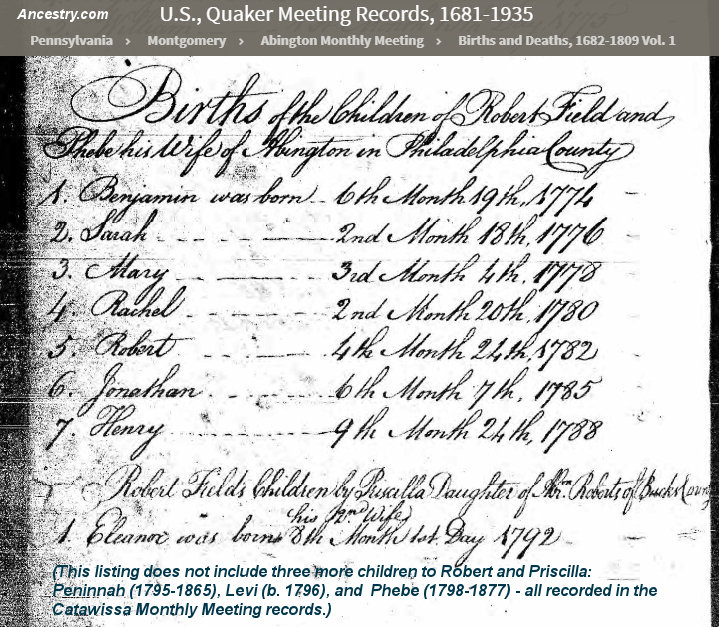
Robert Field's children born in Abington.
Robert was a Quaker. His wife was from a strong Quaker family, the Comly family whose history is on the “To Pennsylvania” page in this website. He has a D.A.R. listing, but never took up arms evidently, simply paid a supply tax in 1779. His first seven children were born in Abington between 1774 and 1788, a rather terrible time to raise a family given that the area north of Philadelphia where they lived was alternately run over by British or American troops, not to mention roving robbers and brigands. The winter of 1779-1780 – fourth child Rachel was born in the middle of that winter – has been called the worst winter of the 18th century; George Washington’s revolutionary troops, quartered 70 miles north, saw a winter much worse than the previous one at Valley Forge.
Robert was a chair maker in Abington in the 1780s before Phebe died in 1788, as did their seventh child, Henry. Three years later Robert married thirty-three-year-old Priscilla Roberts and after the birth of their first child the family moved 90 miles northwest to Catawissa along the Susquehanna River. As a branch of the Exeter Monthly Meeting, Quakers had built a meetinghouse there in 1789 and the family attended meetings there or six miles south at the Roaring Creek Meeting house which was built in 1795. Robert and Priscilla had three more children there before she died in 1799. The nest pretty much empty and alone, Robert married the widow of James Watson, Mary née Bowen, a Maryland native who was the same age as he. The entire family is best recorded in the “Genealogy of Berks”, an unpublished, 1930 handwritten book pictured here.
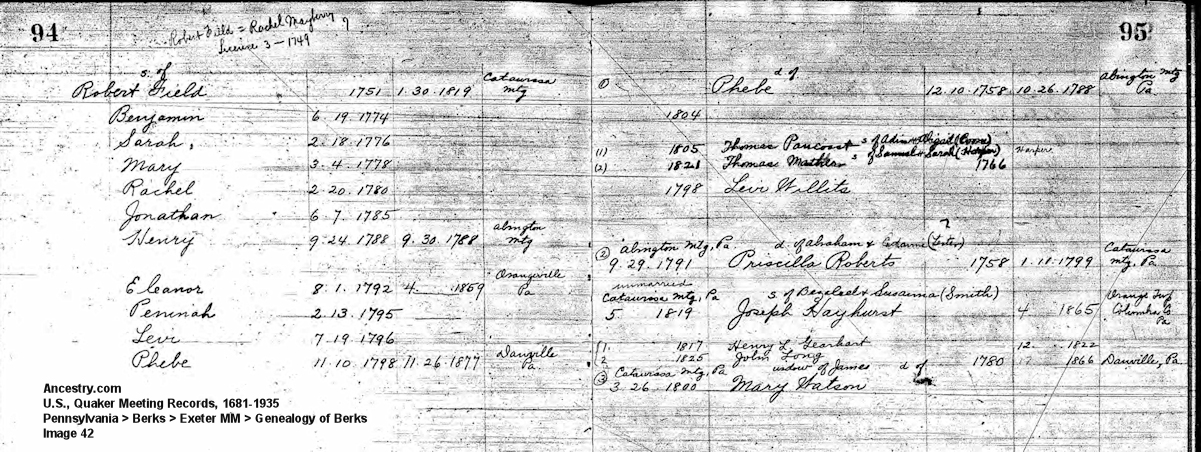
Genealogy of Berks family of Robert and Phebe.
Son of Benjamin?
There is only one source to fully document that Robert was the son of Benjamin Field junior. Only one printed genealogy, the Jennings Genealogy, puts him in the family, and that without a birth date. The births of all the other children are documented in Quaker records except Robert. I questioned whether or not Robert was really the son of Benjamin, but proposed that he was really the son of Benjamin’s older brother Robert. Thanks to cousin Ryan Wadleigh, it seems that I was mistaken when he shared an important document from the Bucks County Orphans’ court. Benjamin’s widow Sarah petitioned the court in September of 1750 to plea that her son Robert was born after the death of her husband Benjamin and that the will, which was written before Robert’s birth, should be amended to include Robert. After summarizing the provisions of the will the document reads “And soon after died to wit on the 12th day of January last. Since which time to wit: on the twenty-fifth day of July last the petitioner was delivered of another son who is named Robert, for whom no provision is made by the said will.” The court went on to say that “…the share or part of the aforesaid Robert Field (born since the making of the will and death of his said father) shall be one-eleventh part of Two thirds part of the clear estate of the said Benjamin Field dec’d which allowing…the share thereof due to the said Robert will be £39..19..8½”. Something like $9300.00 in 2021 money.
(An aside about dates): Benjamin Field junior’s will was proved Feb. 3, 1749
 which was using the Julian calendar and typically double-dated in genealogy records as 1749/50. If one takes that to mean that he died in the early days of 1749 that would be incorrect as far as the Gregorian calendar which has been used in America since September of 1752. That means that he died in 1750 and Robert was born July 25, 1750 by current reckoning. The Orphans’ Court petition made by Robert’s mother Sarah in September of 1750 says “last,” which doesn’t mean the previous year. Two Quaker records of Robert’s death on January 30, 1819 give his age as 68, hence born in 1751 - likely in error by a year, not unusual even today and it really may mean a matter of months difference by the recorder or confusion over the calendar dates.
which was using the Julian calendar and typically double-dated in genealogy records as 1749/50. If one takes that to mean that he died in the early days of 1749 that would be incorrect as far as the Gregorian calendar which has been used in America since September of 1752. That means that he died in 1750 and Robert was born July 25, 1750 by current reckoning. The Orphans’ Court petition made by Robert’s mother Sarah in September of 1750 says “last,” which doesn’t mean the previous year. Two Quaker records of Robert’s death on January 30, 1819 give his age as 68, hence born in 1751 - likely in error by a year, not unusual even today and it really may mean a matter of months difference by the recorder or confusion over the calendar dates.
Benjamin Field, Jr. (1698-1750)
Benjamin3, Robert2, Robert (emigrant)
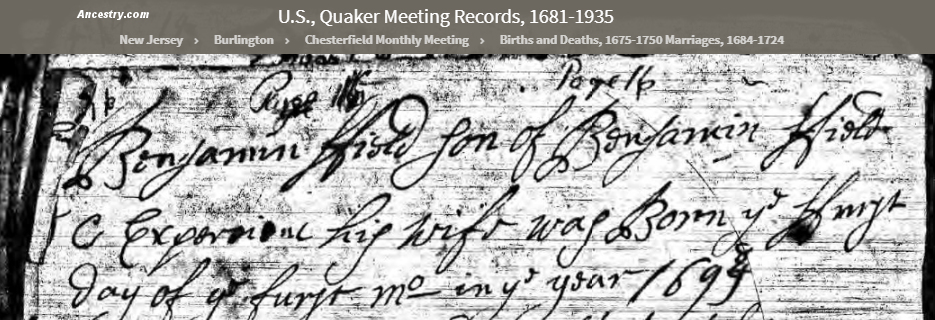
Benjamin junior, the son of Benjamin senior and Experience née Allen, was born “the [first] day of the furst mo in ye year 1698” which is a Quaker date translated as March 1, 1698. The entry in the Quaker record has "1699" and an "8" above the last 9 which may really be a double dated year 1698/1699 given that the date is before March 25th. He was a very young tyke of 3 or 4 when his father died, and only 6 or 7 when his mother died. There is little on him in the Field Genealogy of Frederick Pierce and what is printed of him is in the 1902 Stevenson Genealogy which says he was Register and Recorder of Bucks County from 1721 to 1724; Trustee of the Loan Office in 1743, and was a member of the Pennsylvania Assembly continuously from 1738 to 1745. In July of 1744 he published a reward of 20 shillings for information on a run-away Irish servant, 19-year-old Henry Carty. Henry was likely an indentured servant, not a slave.
Benjamin junior had eleven children with his wife Sarah Stevenson, whom he married in November of 1724 in Bucks County. Sarah was likely pregnant when they married, as their first born, Sarah, was born April 29, 1725. After nine more children she was about three months pregnant when her husband, Benjamin, died on the 12th of January, 1750. Robert was born on the 25th of July, 1750 as we have seen above.
Benjamin, who died in 1750 before the birth of his son Robert, was heir to three generation of American Quakers. Those three generations are discussed further down on this page, but first we turn to the ancestry of Benjamin’s wife, Sarah Stevenson who outlived her husband by at least 14 years, although her death date is not known for sure.
The Stevenson and Jennings lines.
Sarah Stevenson (1706 - )
(Sarah4, Thomas3, Thomas2, Thomas Stevenson (Emigrant))
When her husband, Benjamin junior, died in 1750 Sarah was about three months pregnant with her eleventh child. Three of their girls were either married or would be shortly, but she had a baby and young children to deal with. It is most likely that she is the Sarah Field who married Nicholas Ashton in 1753 three years after the death of Benjamin. Before that, on August 4th, 1751, she was recommended to the meeting of ministers and Elders by the Middletown Monthly Meeting along with Sarah Cary. Quakers don’t ordain ministers as do other sects, but merely recognized that they were ordained by God to give spiritual advice. When Sarah died is unknown – further research is ongoing. She was the daughter of Thomas Stevenson III (1674-1719), and the great-granddaughter of the emigrant Thomas Stevenson, and heir to three generations of Thomas’. Her mother was Sarah Jennings.
Stevenson
Thomas Stevenson III (prob. 1674-1719) - Sarah's father
He married the widow of Edward Pennington, Sarah née Jennings, in February of 1704 after relocating from Flushing, Long Island to north of Philadelphia. He had purchased 1000 acres on the south side of Neshaminy Creek in Bensalem Township. (See the map in the Jennings column.) He was elected a member of the Pennsylvania Assembly in 1710 and served there until his death in 1719; also, one of eight Justices of the Peace in Bucks County. He bought large tracts of land in Pennsylvania, New Jersey, and Maryland, disposing the land to actual settlers. (An extensive list of his purchases is in the Stevenson Genealogy, pages 34-35.) His son-in-law, Benjamin Field junior, was a witness to his will which was probated October 9, 1719.
Thomas Stevenson II (1648-1725) - Sarah's grandfather
Thomas was the second son of the emigrant Thomas. Born in Flushing in 1648 he lived out his life farming land that he had inherited from his elder brother John when John died about 1671. He married Elizabeth, the daughter of Captain William Lawrence with whom he had four children including the son Thomas III (1674-1719) who married Sarah Jennings. In religion the Thomas II was likely not a Quaker until after the death of his first wife about 1683. His second wife is considered by Sevenson (page 19) to be of the Field family per the terms of the will of Robert Field (ca.1661-1734), Benjamin's brother. However, his reading of the will is different than mine. During his life, Thomas II held several public offices, including being commissioned Justice of the Peace for Queens County in 1685. As a Quaker he became acquainted with Samuel Jennings and through his influence began to buy property in New Jersey and Pennsylvania, although it would be his sons who would relocate to that area, taking up residence in Bucks County, Pennsylvania having married Sarah Jennings in 1704. The Jennings family and the Stevenson family were very close; Samuel Jennings’s will of 1708 named as executors Thomas and his two brothers, William and John along with their wives, Samuel’s daughters.
Thomas Stevenson I (1615-1668) - the emigrant - Sarah Stevenson’s great-grandfather
Thomas came to Connecticut via Virginia about 1643 and about the first thing he did was fight Indians. Joining the troops of Captain John Underhill, a leader in the Pequot Wars of 1636, he participated in 1644 in a combined Dutch and English defeat of Indian tribes around New Amsterdam. Along with Underhill and others, he settled in Southold on Long Island and in 1645 took a wife, the widow Mary Barnard, née Bullock, whose husband had probably been killed in the Indian fighting. Southold is on the eastern end of Long Island, but Thomas did not stay there very long, moving to the other end of the island where he secured a patent from the Dutch for land adjoining Newtown.
Click to see the location of Southold in the map used in the Introduction page. There he got in trouble with his neighbors over access to common land and roads, legal suits that dragged on for years even though he apparently had the favor of the Dutch Governor, Peter Stuyvesant. Thomas died intestate in the first half of 1668 per the records of the New York Surrogates Court, leaving lands at Newtown and in England to the administrator of his estate.
Descendancy to Rachel Field (1780-1851):
Rachel Field6, Robert Field5, Sarah Stevenson4, Thomas III3, Thomas II2, Thomas Stevenson (1615-1668) (Emigrant)
Jennings
Sarah Jennings (1679-1733) Sarah Stevenson's mother
Thomas Stevenson III was not her first husband. She was the widow Sarah Pennington when she married Thomas in 1704. Her first husband, Edward Pennington, died when they had been married only two years, but she bore him a son, Isaac Pennington (1700-1740). She had seven children with Thomas, five of them living to maturity and marrying. At 54 and widowed for 14 years, she died in February of 1733 and is buried in the Middletown Friends Burying ground in Langhorne, Bucks County.
Samuel Jennings (1648-1708) – Sarah Stevenson’s grandfather
Born in England, his parents were closely connected to the Quaker sect founder, George Fox. At age 32 (1680) Samuel immigrated from England to Burlington County in New Jersey amidst a good deal of controversy not only among Quakers, but the political administration of the Provence of New Jersey which had been split into East and West Jersey. The political schemes of the 1680s in New Jersey are hard to understand, but suffice it to say Jennings was appointed for three years in 1682 Deputy-Governor of West Jersey by the London based colonial Governor who was not popular with William Penn or the Quakers and who died in 1687 never having set foot in America. That led to re-organization and dysfunction and in 1702 the two halves were united as one province. Jennings served as Speaker of the General Assembly two years before his death in 1708. The year before he drafted an appeal to Queen Anne about the mis-government of the new Governor of the Jersey’s, Lord Cornbury, which earned Cornbury’s wrath, reportedly saying, “Jennings was the most impudent man he ever knew.”
In 1681 he purchased a large tract of land in Burlington Township which today is Green Hill Farm, on the National Register for the home that was built there a century later; he built a brick home that was still standing in 1902.
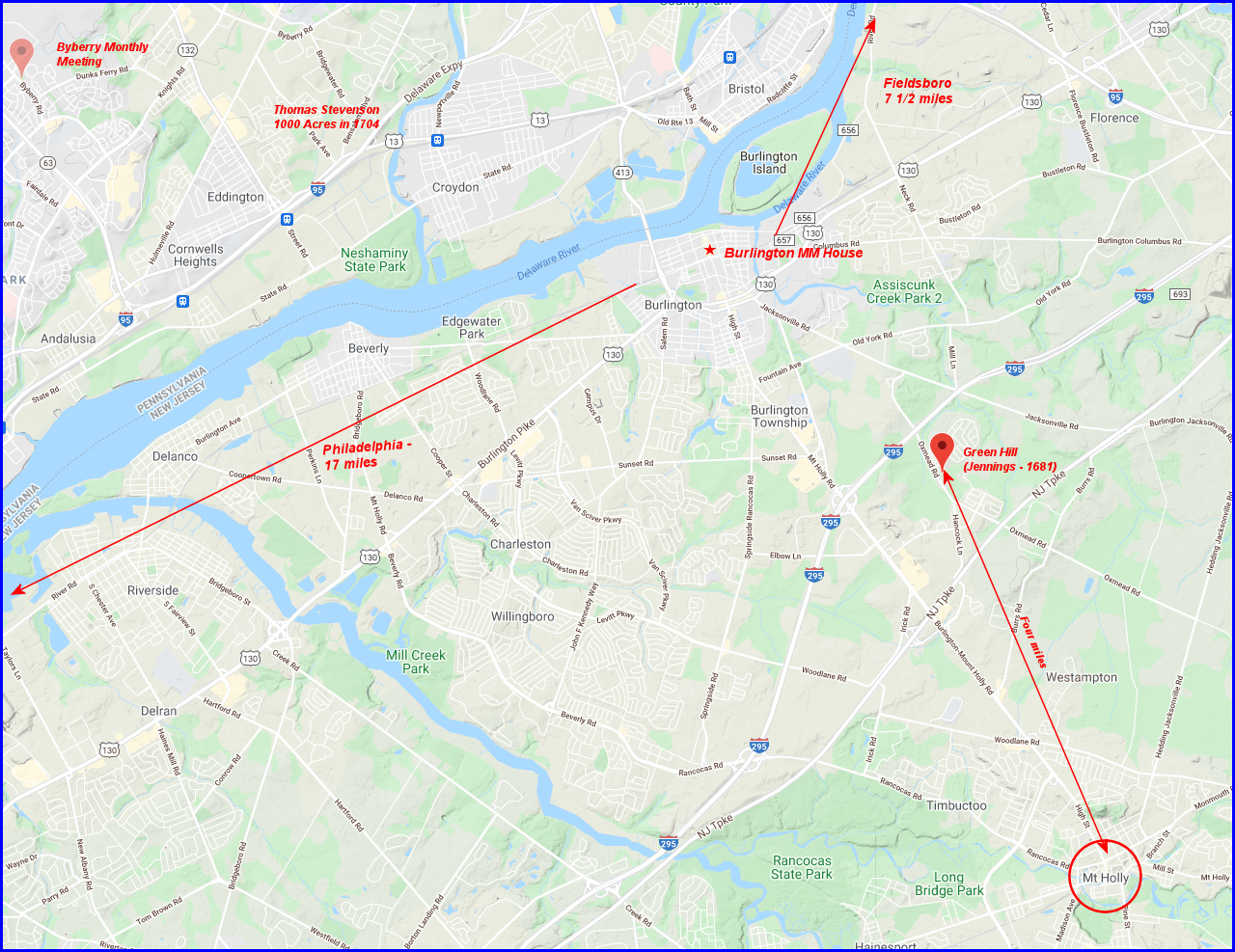 (Green Hill Farm was only 4 miles northwest of Mount Holly where the only Quaker ancestor on my mother’s side lived, albeit a generation or two later.)
Samuel got himself embroiled in controversy about Quaker doctrines which took him back to London in 1694 to successfully plead his case.
(Green Hill Farm was only 4 miles northwest of Mount Holly where the only Quaker ancestor on my mother’s side lived, albeit a generation or two later.)
Samuel got himself embroiled in controversy about Quaker doctrines which took him back to London in 1694 to successfully plead his case.
As seen, he and the Stevenson family had a close connection, so much so that the author of the 1902 Stevenson Genealogy devoted an entire chapter to him. Three of his daughters, including Rachel Field’s great-grandmother Sarah Jennings, married into the Stevenson family and along with their husbands were named as executors of Samuel’s will written in 1708, the year he died. Samuel had married Ann Ollife in 1672 in England. His only son died at 16, two daughters died young.
For more information on the history of the Burlington Quaker Meeting house see the link under Other Meetings.
Descendancy to Rachel Field (1780-1851):
Rachel Field5, Robert Field4, Sarah Stevenson3, Sarah2, Samuel Jennings (1648-1708) (Emigrant)
The first three generations of Rachel Field's ancestors in America, to wit,
Robert the emigrant, his son Robert, and his son Benjamin senior.
Rachel6, Robert5, Benjamin junior4, Benjamin senior3, Robert2, Robert Field (Emigrant)
The first source listed below is George McCracken’s 1959 article “The Fields of Long Island” published in the NEHG’s Register. I have used it extensively and it is perhaps the definitive article on this family in Long Island, correcting errors in other publications and articles.
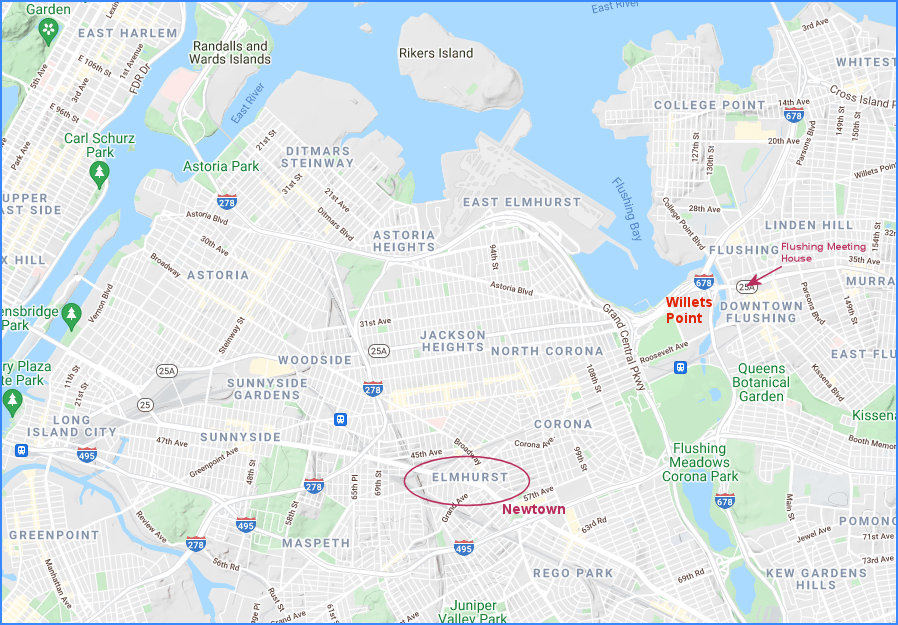
Locations in the now Borough of Queens on Long Lsland.
Robert Field I - the Emigrant
Robert Field was likely one of those who sailed from Southampton, England in 1635 on the ship James. The first record of him in New England is in Portsmouth, Rhode Island in 1638
where he was one of twelve men granted lots and was listed as a Freeman in Newport County, R.I. in 1639. Sometime in the next six years he moved across the Sound and
settled in Flushing, Long Island. He became a Quaker, something that Peter Stuyvesant, then governor of New Netherland, had banned. In 1657, Robert, along with his brother Anthony,
was one of the signers of the Flushing Remonstrance requesting an exemption to the ban in a document that is considered by some to be the precursor of the Third Amendment
in the U.S. Constitution’s Bill of Rights. The Society of Friends Meeting House on Northern Boulevard in Flushing, Queens,
built in 1694 is now the oldest house of worship in continuous use in New York State.
For more information on the history of the Flushing Meeting and the Remonstrance see its website at Flushing Meeting Religious Society of Friends.
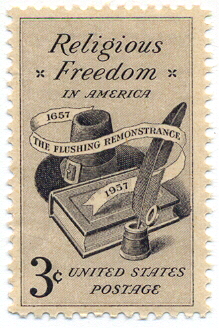
Robert Field II (By 1669 - 1701)
Robert2, Robert (Emigrant)
Robert, the son of the emigrant married, according to some sources, Susannah [Stevenson], although her maiden name is a matter of very much debate and not proven.
In any case, Robert married about 1660 in Newtown, Long Island,
Susannah ______. (Newtown is now the neighborhood of Elmhurst in Queens. Click on the map above.) Nine children are attributed to Robert and Susannah Field,
their youngest son, Benjamin Field senior, marrying Experience Allen.
Following the death of her husband, Susannah removed to Chesterfield, New Jersey where she died in 1702.
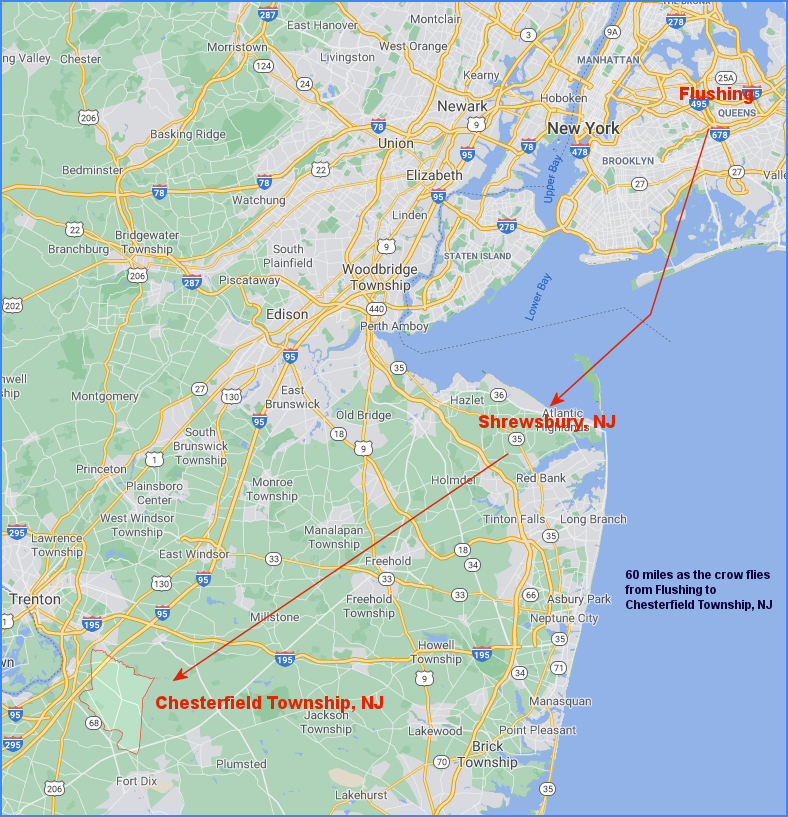
Flushing, Long Island to New Jersey
Benjamin Field senior (abt 1669 – 1702)
Benjamin3, Robert2, Robert (Emigrant)
Benjamin Field was born in Newtown, Long Island, his wife Experience Allen, was of the Allen family of Sandwich, Plymouth Colony, born in 1669.
(More on the Allen and Howland families on the Introduction page.
Experience’s family had relocated to Shrewsbury, New Jersey where the historic Allen House, likely built by a relative, is today operated as a
historic landmark. They married in Shrewsbury in 1692.
Benjamin and his wife Experience both died quite young, leaving four minor children, the first son named after Benjamin’s father Robert.
Experience requested in her will that her father, Jedidiah Allen, “cast a fatherly eye upon the children.” They were likely brought up in the household of
grandfather Jedidiah, aunt Susannah Marriot or uncle Nathan Field, Susannah and Nathan being the executors of her will. It was a small community; a witness to
Experience’s will was the aforementioned Samuel Jennings, the stout Quaker whose granddaughter, Sarah Stevenson, would marry Benjamin and Experience’s son Benjamin Field junior, the grandfather of Rachel Field.
With that we can return to the top of this page to Robert Field who died in Catawissa in 1819 and his father Benjamin junior.
Locations & Families at Monthly Meetings north of Philadelphia
A bigger, more complete map which also shows the approximbate location and size of the Meetings is on the Maps page.
Click the links for the Meeting's history online May, 2021. (new window or tab.)
Sources:
Other specific sources in the footnotes.
Perhaps the most important source for the early Field family is the first one, the McCracken article. Anyone researching this family who hasn't seen it should do so.
- McCracken: George E. McCracken Ph.D., F.A.S.G., "The Fields of Flushing, Long Island," New England Historic and Genealogical
Register, Vol. 113 (July 1959): 197-216; 267-289. ($ Available from me if needed.)
- Field Genealogy - Frederick Clifton Pierce, Field genealogy; being the record of all the Field family in America…
2 Volumes (Chicago, IL: W.B. Conkey, 1901) https://archive.org/details/fieldgenealogybe01inpier/page/n5/mode/2up
(Many errors and incompletions, but still a valuable source.)
- Jennings book: William Henry Jennings, A genealogical history of the Jennings families in England and America
(Columbus, Ohio: Mann & Adair, 1890); page 348-9 for Sarah Stevenson & Benjamin Field: https://archive.org/details/genealogicalhist21jenn/page/742/mode/2up
- Stevenson book: John R. Stevenson, Thomas Stevenson of London, England and is descendants (Fleminton, N.J.: H.E.Deats, 1902), page 31;
Online at http://catalog.hathitrust.org/Record/005763752
- Comly, George Norwood, Comly family in America, descendants of Henry and Joan Comly, who came to America in 1682 from Bedminster, Somersetshire, England. (Philadelphia, 1939). Online at HathiTrust.org: https://catalog.hathitrust.org/Record/005730402; or the entire book as a PDF is at http://www.seekingmyroots.com/members/files/G001349.pdf (Accessed 6/15/2021 - 63 MB)
- Quaker Records searchable at Ancestry.com ($): https://www.ancestry.com/search/collections/2189/
- Dates for Quakers and the change from New Style to Old Style in 1752 is often a challenge. A good guide is “The Quaker Calendar” webpage at the
Friends Historical Library at Swarthmore College: https://www.swarthmore.edu/friends-historical-library/quaker-calendar
Footnotes: